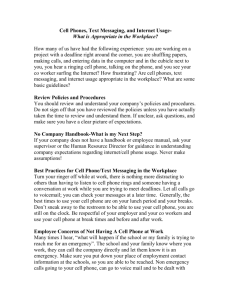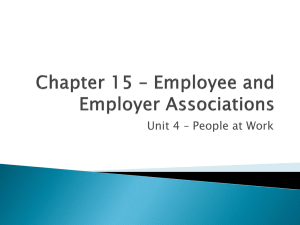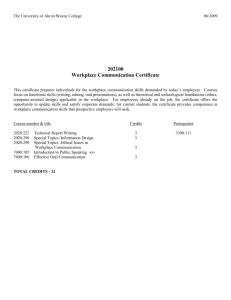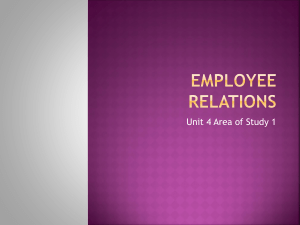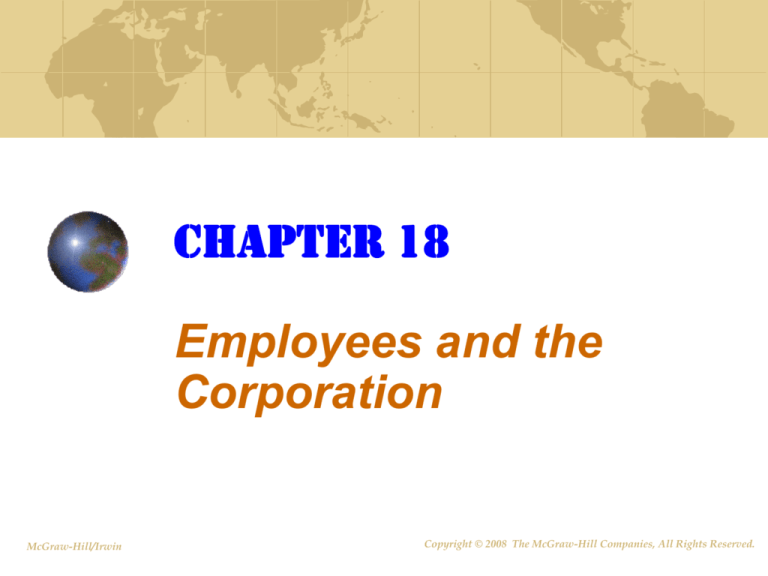
Chapter 18
Employees and the
Corporation
McGraw-Hill/Irwin
Copyright © 2008 The McGraw-Hill Companies, All Rights Reserved.
Ch. 18: Key Learning Objectives
Understanding workers’ rights to organize unions and bargain
collectively
Knowing how government regulations assure occupational
safety and health and what business must do to protect workers
Evaluating the limits of employers’ duty to provide job security to
their workers
Appraising the extent of employees’ right to privacy, when
businesses monitor employee communications, police romance
in the office, test for drugs or alcohol, or subject employees to
honesty tests
Debating if employees have a duty to blow the whistle on
corporate misconduct, or if employees should always be loyal to
their employer
Assessing the obligations of transnational corporations to their
employees around the world
18 - 2
The Employment Relationship
Employees are an important market stakeholder
group
Employees are responsible for carrying out the work
of the company
At the same time, employees are dependent on the
company for their livelihood
Nature of the employment relationship conveys rights
and duties on both sides
The next slide outlines these points related to employees
and employers
18 - 3
Figure 18.1
Rights and Duties of
Employees and Employers
18 - 4
Workplace Rights
Legal guarantees of U.S. workers
1. Right to organize and bargain collectively
2. Right to safe and healthy workplace
3. Right (to some degree) to job security
18 - 5
Right to Organize and Bargain Collectively
In the U.S. and many other countries, employees
have a legal right to organize labor unions and to
bargain collectively with employers
Workers have a right to hold an election to decide which
union will represent them
Labor unions have the right to negotiate wages,
working conditions, and other terms of employment
Employers are required to bargain with unions in good faith
If agreement can’t be reached, a strike might occur
18 - 6
Right to Organize and Bargain Collectively
Influence of labor unions has varied during periods in
U.S. history:
New Deal period, in the 1930s, were very popular
Since 1950s has been decline in union membership
In 2005, only 13% of U.S. workers are members of a union
Percentage of government workers is higher, 37%
Some predict resurgence of union activity in coming years
Some unions have departed from adversarial
approach to working cooperatively with management
Examples include unions at Saturn, AT&T, Kaiser
Permanente
18 - 7
Right to Safe and Healthy Workplace
U.S. Department of Labor estimates annually over 4
million workers in private industry are injured or
become ill on the job
Manufacturing jobs are more risky than service jobs
Occupational Safety and Health Act, passed in 1970,
gives workers the right to a job “free from recognized
hazards that are causing or likely to cause death or
serious physical harm”
Law is administered by OSHA – Occupational Health and
Safety Administration
Agency has helped reduce employee deaths and injuries,
since 1970 death rate has been cut in half
18 - 8
Right to Safe and Healthy Workplace
Working conditions remain very dangerous in many
developing countries:
In Bangladesh’s fast-growing garment and textile industry,
fires and building collapses have killed or seriously injured
more than 2,800 Bangladeshi workers since 1990
Efforts by governments, businesses, and unions to improve
conditions of workers in international factories is discussed
later in this chapter
Special issue of workplace violence is discussed in
next slide
18 - 9
Exhibit 18.A
Excerpts
Violence in the Workplace
Stories of angry employees, ex-employees, or associates of
employees attacking workers, co-workers, or superiors at work are
common.
Homicide is the fourth-leading cause of death on the job. In U.S.
annually 600 workers are murdered, and 2 million are assaulted.
Survey by the International Labor Organization found workplace
assaults were more common in other industrial nations, including
France, England, and Argentina. Four percent of workers in the
European Union said they had been subjected to physical violence
in the past year.
OSHA has developed recommendations to help employers reduce
the risk of violence. Employers should try to reduce high-risk
situations, and train employees in what to do in an emergency
situation.
18 - 10
The Right to a Secure Job
In U.S. employment-at-will has been legal standard since
1800’s
Employees are hired and fired at discretion of the employer
But, some restrictions on employment-at-will; employer
cannot fire a worker:
Because of race, gender, religion, national origin, age, or disability
If would constitute a violation of public policy, as determined by the
courts
If, in doing so, it would violate the Worker Adjustment Retraining
Notification Act
If worker is involved in union organizing or other activity
If would violate an implied contract, such as a verbal promise, or
basic rules of “fair dealing”
18 - 11
The Right to a Secure Job
Commitment between employees and employers
has evolved with time and changing norms
This “implied understanding” (as opposed to legal contract)
has been named the social contract
Can be used to describe the relationship between the
company and other stakeholders, but is most often used to
describe the employer/employee one
Downsizing, and reengineering initiatives of the late
1980s resulted in “new social contract”
Employers offer challenging work, performance-based
compensation, and ongoing professional development but
not long-term job security
Employees are expected to make commitment to job tasks,
work team, and success of the company
18 - 12
Privacy in the Workplace
In work context, privacy rights refers to protecting
an individual’s personal life from unwarranted
intrusions by the employer
5 areas where this might present a dilemma
1. Electronic monitoring
Companies can gather, store, and monitor information about
employees’ activities. This may be at odds with an employee’s
right to privacy.
2. Romance in the workplace
If office romance goes sour, one of the people may sue,
charging sexual harassment. When one person in a
relationship is in a position of authority, s/he may be biased in
an evaluation of the other’s work.
18 - 13
Privacy in the Workplace
Additional employee privacy rights dilemmas:
3. Employee drug use and testing
Three-fifths of companies test employees or job applicants for
Illegal substances. Arguments in debate over drug testing are
shown on next slide.
4. Alcohol abuse at work
U.S. businesses lose an estimated $70 billion per year in
reduced productivity directly related to alcohol abuse. Many
employers now offer EAP’s (employee assistance programs) to
help employees with alcohol and drug abuse issues.
18 - 14
Figure 18.2
Pros and Cons of Employee
Drug Testing
18 - 15
Privacy in the Workplace
Additional employee privacy rights dilemma
5. Employee theft and honesty testing
2004 survey of large U.S. retail stores found ½ of inventory
losses were due to employee theft, valued at $15 billion.
Employee theft is significant problem in Europe too. Use of
honesty tests is controversial.
In all these areas businesses must balance their
needs to operate safety, ethically and efficiently with
employee’s right to privacy
18 - 16
Whistle-blowing and Free Speech in the
Workplace
Free speech in the workplace
Another area where employer and employee rights and
duties sometimes conflict
U.S. Constitution protects free speech; however does not
specifically protect freedom of expression in the workplace
Employees are not generally allowed to speak out against
their employers, due to legitimate interests of the business
When society’s interests override those of the individual
business, employee may feel the need to speak out or “blow
the whistle”
18 - 17
Whistle-blowing and Free Speech in the
Workplace
Whistle-blowing: when an employee believes his or her
employer has done something this is wrong or harmful to
the public, and he or she reports the alleged misconduct
to the media, government or high company officials
4 conditions must be satisfied to justify whistle-blowing
1. Organization is doing something that seriously harms others
2. Employee has tried and failed to resolve the problem
internally
3. Reporting the problem publicly will probably stop or prevent
the harm
4. The harm is serious enough to justify the probable costs of
disclosure to the whistle-blower
18 - 18
Working Conditions around the World
Laws and practices that establish fair wages, acceptable
working conditions, and employee rights vary greatly
around the world
One very public issue is sweatshops
Factories where employees, sometimes including children, are
forced to work long hours at low wages, often under unsafe
working conditions
Number of well-known companies have been criticized for poor
working conditions in overseas factories – Nike, Wal-Mart,
Disney, McDonald’s
18 - 19
Fair Labor Standards
Labor standards means the conditions under which
a company’s employees, or the employees of its
subcontractors, work
Universal rules or standards related to these are
called fair labor standards
18 - 20
Fair Labor Standards
How establish fair labor standards for multinational
corporations is debated, approaches include:
Voluntary corporate codes of conduct
Non-governmental organizations labor codes
• Social Accountability (SA) 8000 establishes criteria for
“good working conditions” certification
• Other standards covered in Ch. 7
Industry-wide labor codes
• Businesses work with other sectors to define standards
• Example of Electronic Industry Code of Conduct
developed by HP, IBM, and Dell, later endorsed by
Cisco and Microsoft; applies uniform standards to their
global supply chains
18 - 21
Issues Designing Fair Labor Standards
Common questions emerge
1. What wage level is fair?
•
•
Should market set the standards?
Do multinationals have a responsibility to provide a wage that
supports decent standard of living?
2. Should standards apply to just the firm’s own employees or
all workers having a hand in making the product?
•
Responsibility of firm to its own employees is clear,
responsibility to subcontractors employees is indirect
3. How should fair labor standards be enforced?
•
•
Who should be responsible for monitoring? The company or
an independent body?
Mattel has set a good example for this – shown on next slide
18 - 22
Exhibit 18.Da
Excerpts
Monitoring Compliance at Mattel, Inc.
Mattel, Inc. is the world’s largest toy company; many of its
products are manufactured in overseas factories, mostly in
Asia. In 1997, Mattel developed a detailed code of conduct,
called its Global Manufacturing Principles.
Mattel also considered how it could best enforce its code – and
convince its customers it was serious about doing so. The
company created an independent auditing organization, the
Mattel Independent Monitoring Council (MIMCO). Chaired by
three outside experts, MIMCO was given a generous budget
and access to all facilities and records of Mattel and its subcontractors, and was charged with carrying out regular
inspections – and making the results public. In 2003, MIMCO’s
activities were taken over by the International Center for
Corporate Accountability (ICCA), a nonprofit organization that
conducted independent audits for corporate clients.
18 - 23
Exhibit 18.Db
Excerpts
Monitoring Compliance at Mattel, Inc.
Since its first external audit in 1999, Mattel has made public a
series of reports on company-owned and contract factories in
China, Indonesia, Malaysia, Thailand, and Mexico. The
independent audits show that although the company has
generally complied with its own code, some problems have
remained, such as at a plant in Mexico where workers
complained that they had to stand without a break for eight
hours a day. The company quickly corrected the problem.
Mattel’s pioneering effort to establish fully independent and
transparent monitoring has been a model for other companies,
such as Freeport-McMoran Copper & Gold. ICCA’s audit of
Freeport’s controversial mining operation in Indonesia was
released to the public in 2005.
18 - 24

